Things to do in Hong Kong
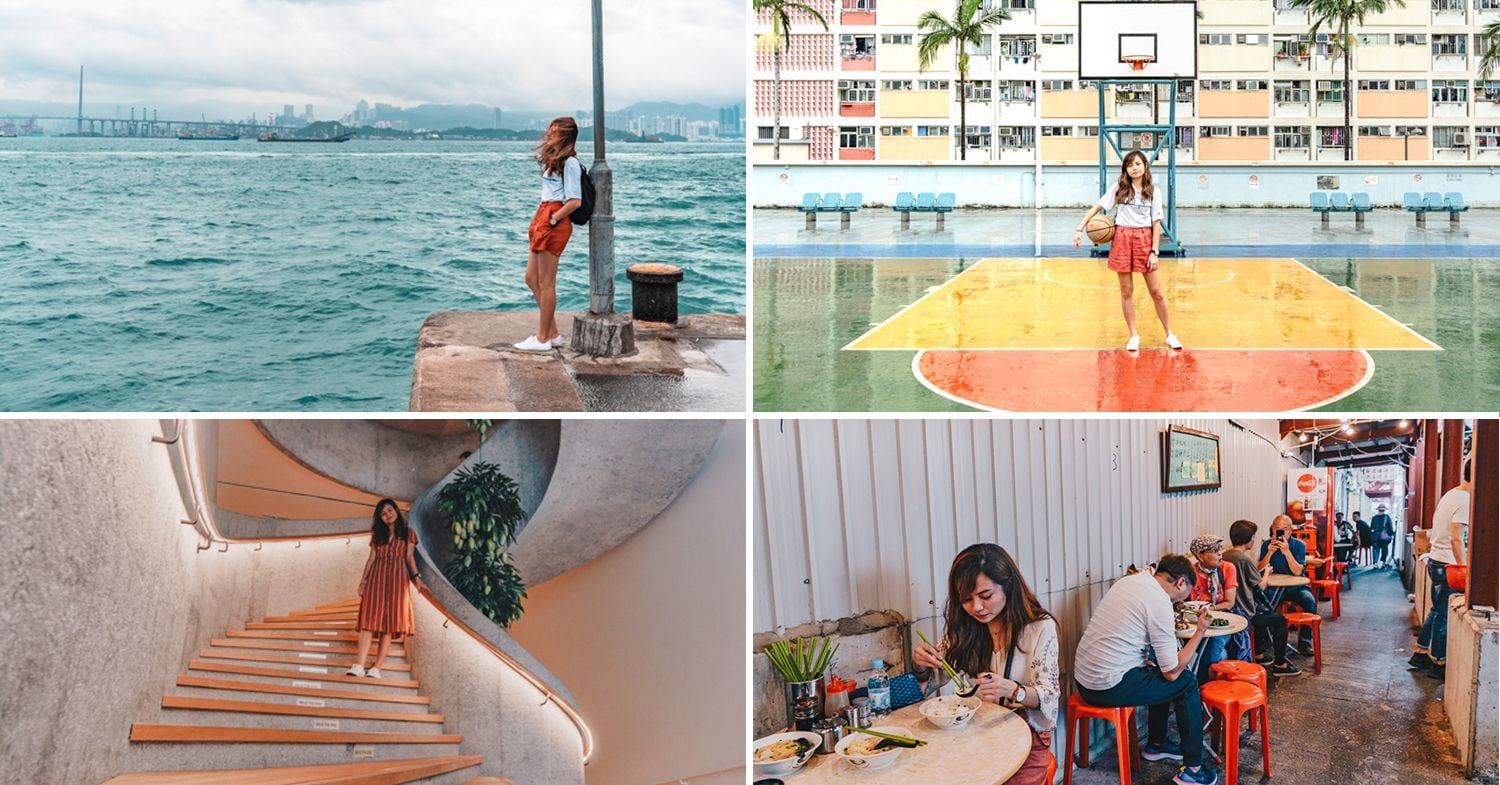
Every visit to Tim Ho Wan warrants a massive urge to visit Hong Kong and sweep out all the dim sum available. But beneath the juicy siew mais, the famous skyline over Victoria Harbour, and the classic Hong Kong Disneyland lies a myriad of alternative experiences offering a fresh new look into the charming city.
From fascinating old shops to a new art centre, all painting a new aesthetic of Hong Kong, these activities are bound to get you crossing off the calendar for your next getaway to Hong Kong.
1. Visit a former police station and prison turned IG spot
Art is rarely the first thing to come to mind when thinking of Hong Kong, but Tai Kwun Centre for Heritage and Arts, which opened its doors in May 2018, aims to change just that.
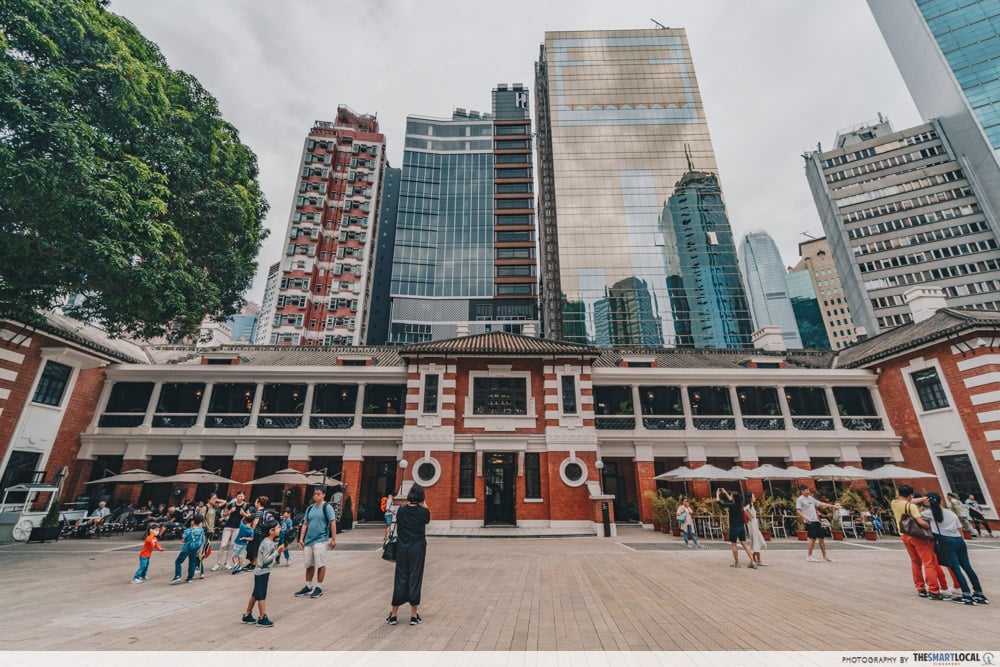 This swanky building was once a police barracks!
This swanky building was once a police barracks!
The centre is Hong Kong’s newest landmark, and is the city’s rising cultural hub for heritage and arts. It’s photogenic at every turn, with an interesting mix of old historic buildings and new state-of-the-art buildings creating a space worthy of an architect’s dream.
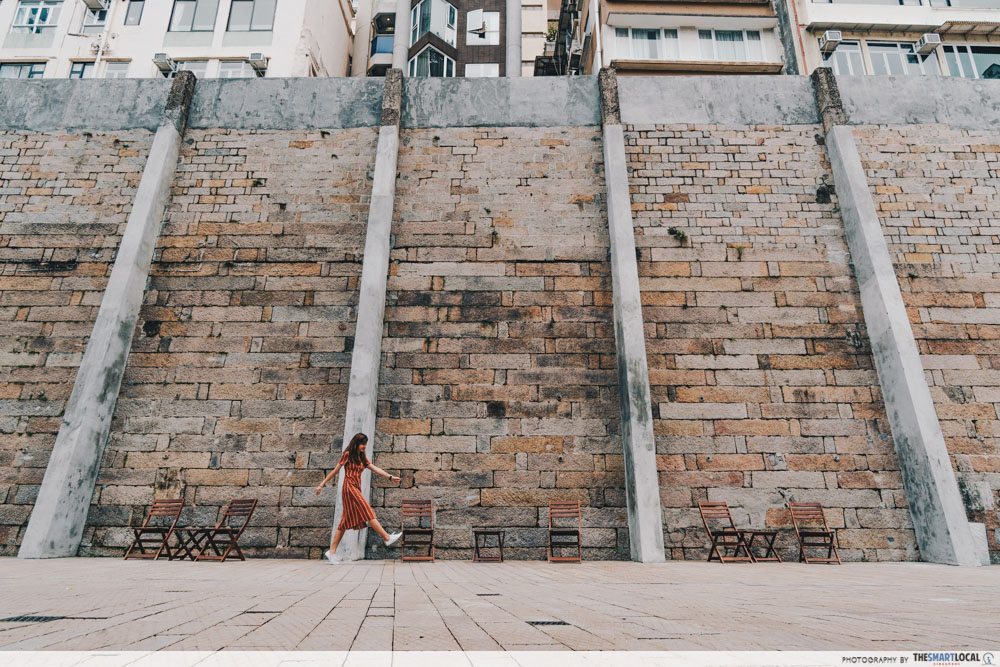 Tall prison walls surround the heritage-rich art centre
Tall prison walls surround the heritage-rich art centre
Most of the compound was restored from Hong Kong’s old Central Police Station, which means you get to walk along the Victoria Prison walls and relish a space filled with decades of Hong Kong’s history.
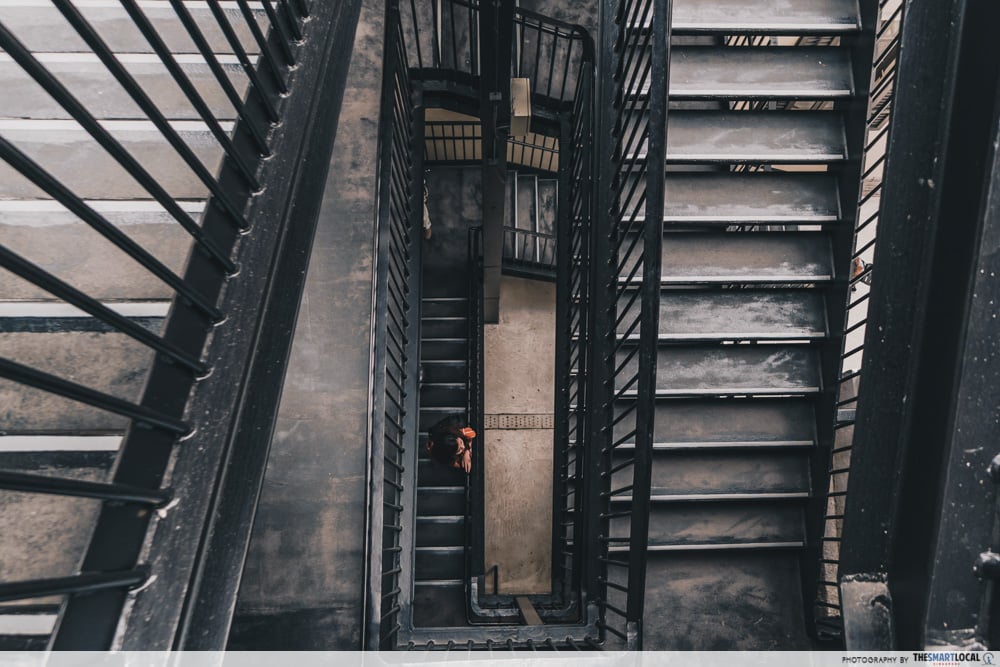 Look out for the photo opportunities at every corner!
Look out for the photo opportunities at every corner!
After revisiting the past, revel in the present at JC Contemporary, a non-profit art centre showcasing modern art installations and programmes.
 If stairs back home looked like this, I’ll walk them every day
If stairs back home looked like this, I’ll walk them every day
Tai Kwun Centre for Heritage and Arts
Address: 10 Hollywood Road, Central
Opening hours: Tai Kwun Site: 10am – 11pm daily | Exhibition Venues: 11am – 6pm
Nearest MTR station: Central (7 min)
2. Track down an instafamous pier from your Explore feed
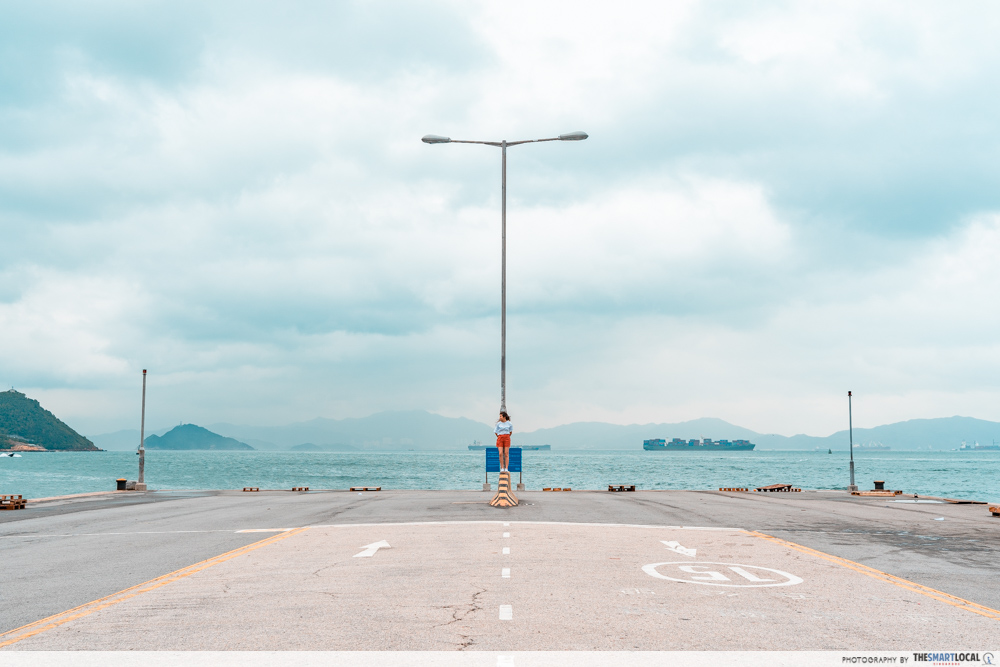 We visited the pier in the morning at 9am on a weekday to avoid crowds.
We visited the pier in the morning at 9am on a weekday to avoid crowds.
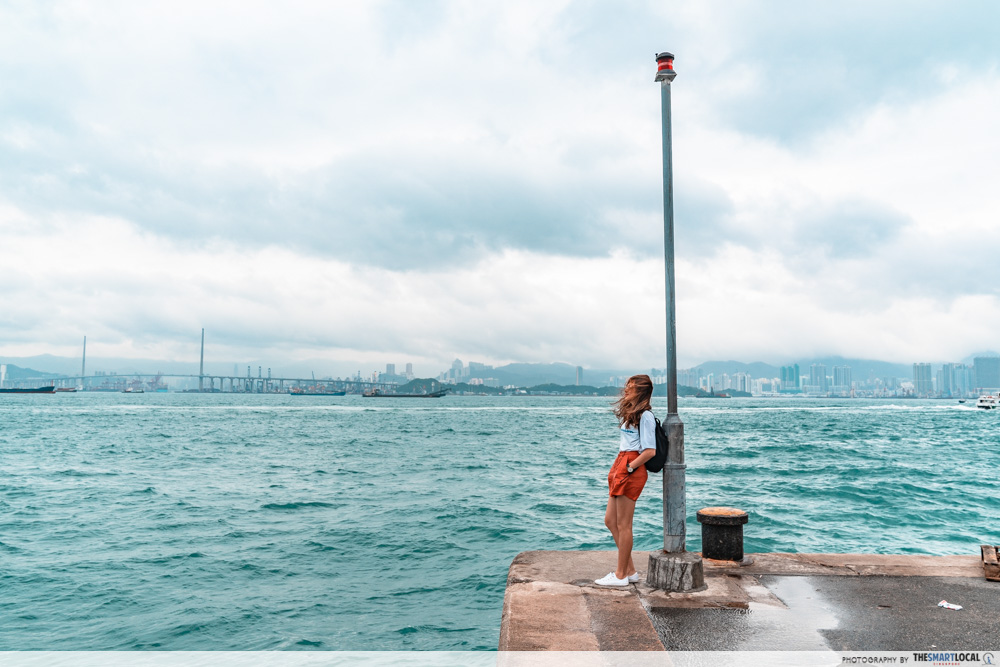
The real name of this pier is Western District Public Cargo Working Area, which sounds a lot less exciting than it actually is. But regardless of what people call it, this pier, located at the edge of Hong Kong Island, is a beautiful respite from city life.
The cool sea breeze is the perfect cherry on top for the numerous photo spots scattered along the pier. Graffiti-covered shipping containers, scattered wooden crates, turquoise seas and the Hong Kong skyline – all in one place. What more can a *cough* budding influencer and a photographer wish for?
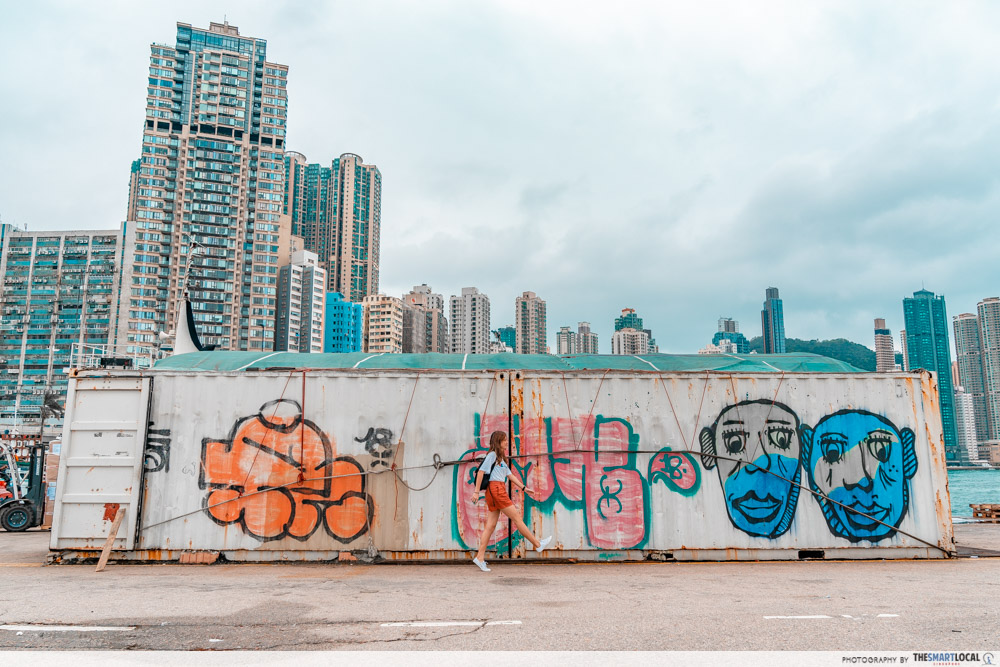 Shipping containers around the pier have been given a hip makeover by graffiti artists
Shipping containers around the pier have been given a hip makeover by graffiti artists
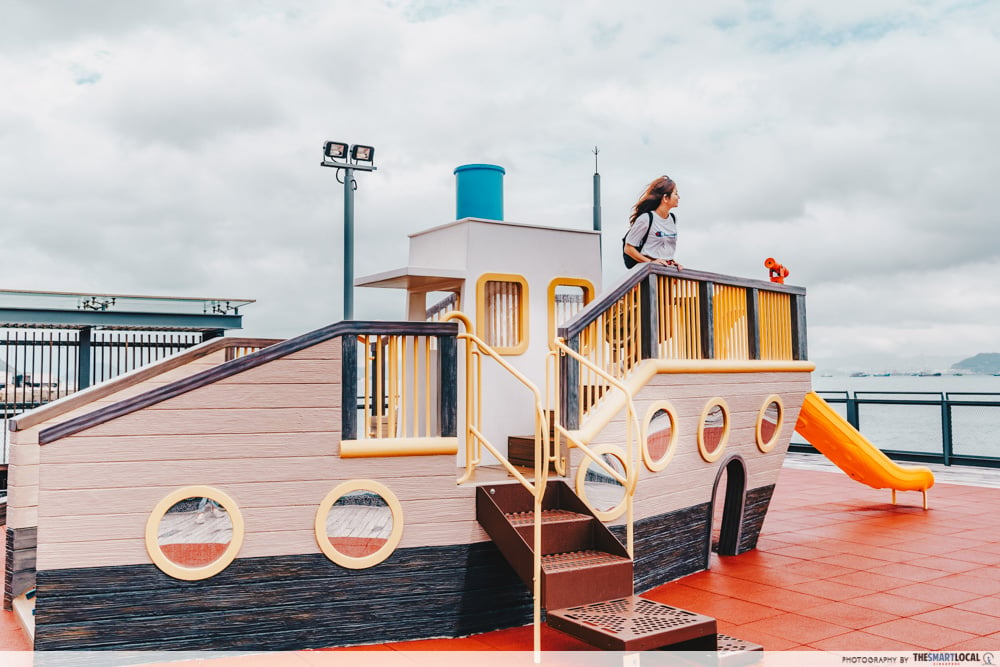 In Singapore, we have the floating platform; in Hong Kong, we have the floating playground
In Singapore, we have the floating platform; in Hong Kong, we have the floating playground
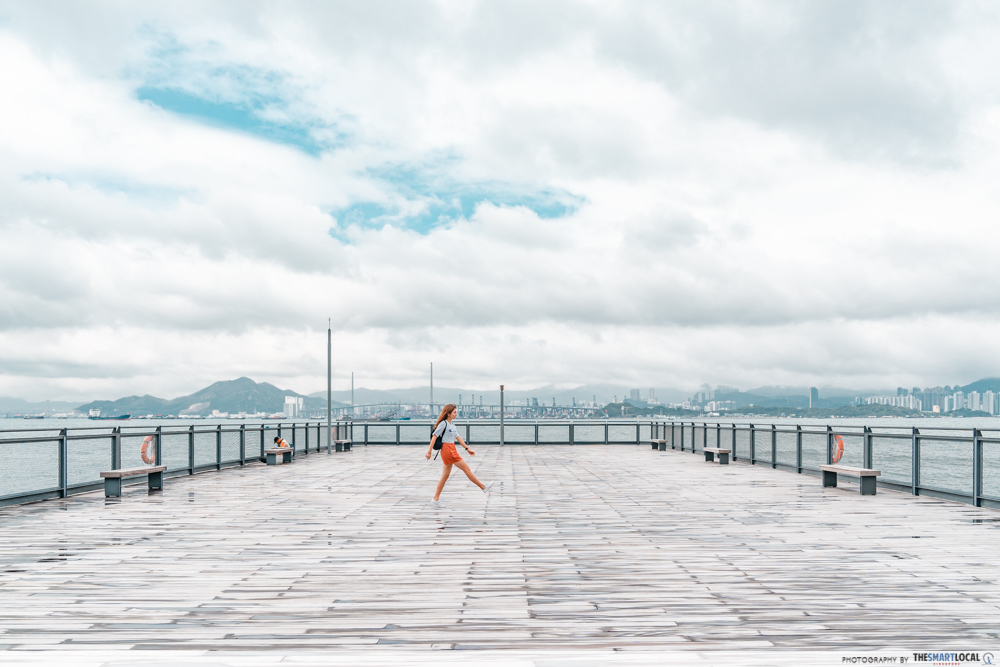 A wharf for the minimalists
A wharf for the minimalists
Western District Public Cargo Working Area
Address: 8 Fung Mat Road, Sai Wan
Opening hours: 24 hours
Nearest MTR Station: Hong Kong University (15 min walk)
3. Explore HK’s “HDB estates” in Nam Shan Estate and Choi Hung
Nam Shan Estate
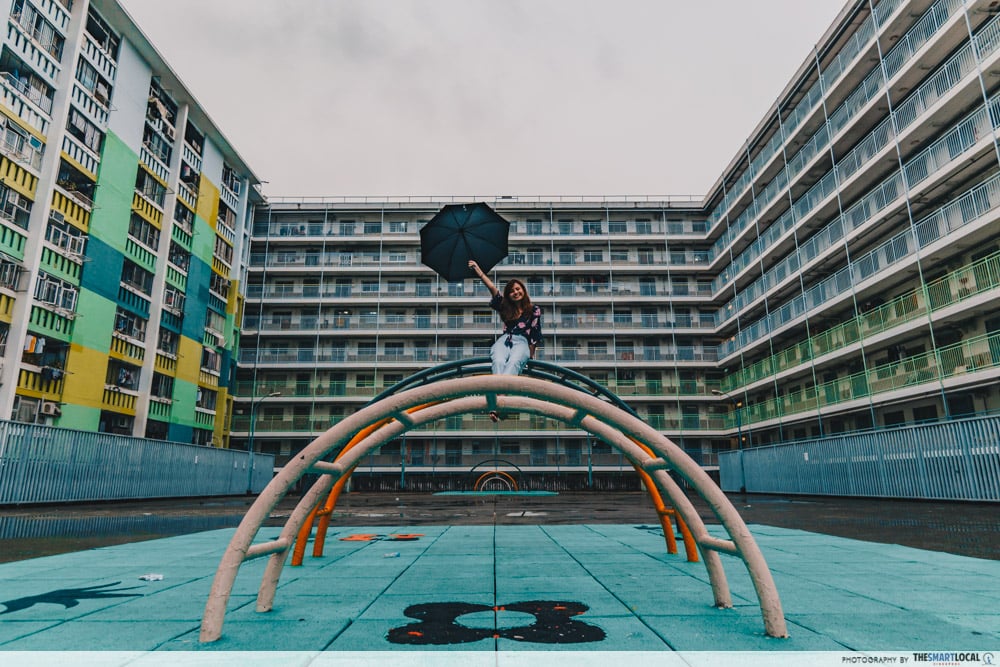 Throwback to the times when playgrounds need not have suspended swings and winding slides
Throwback to the times when playgrounds need not have suspended swings and winding slides
Nam Shan Estate‘s playground complex is the epitome of rustic beauty. The old-school playground features bent metal poles and faded mats set against the backdrop of cramped apartment units, offering a look into the simpler times of Hong Kong’s past. It’s hard to imagine that this gloomy playground once had its lively days when kids instead of photographers flocked the area.
Be sure to continue down to the wet market below the playground, a slow-moving and largely empty market with mostly elderly customers gathering around empty tables. The quietness of the market creates a surprisingly comforting air of tranquility.
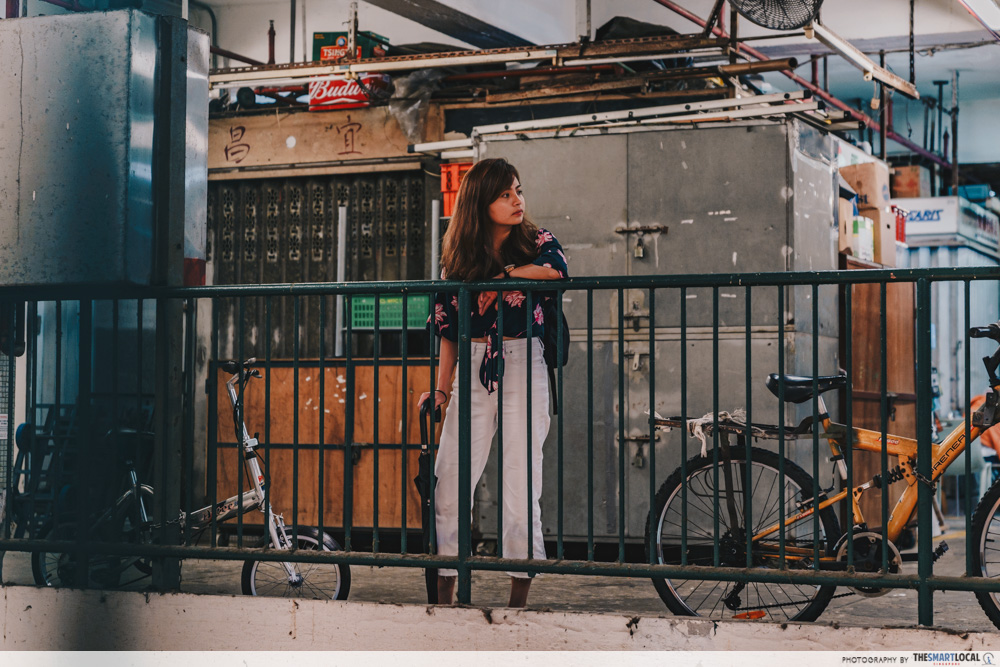
Nam Shan Estate
Address: Nam Shan Chuen Road, Shek Kip Mei
Nearest MTR Station: Shek Kip Mei (7 min walk)
Choi Hung Estate
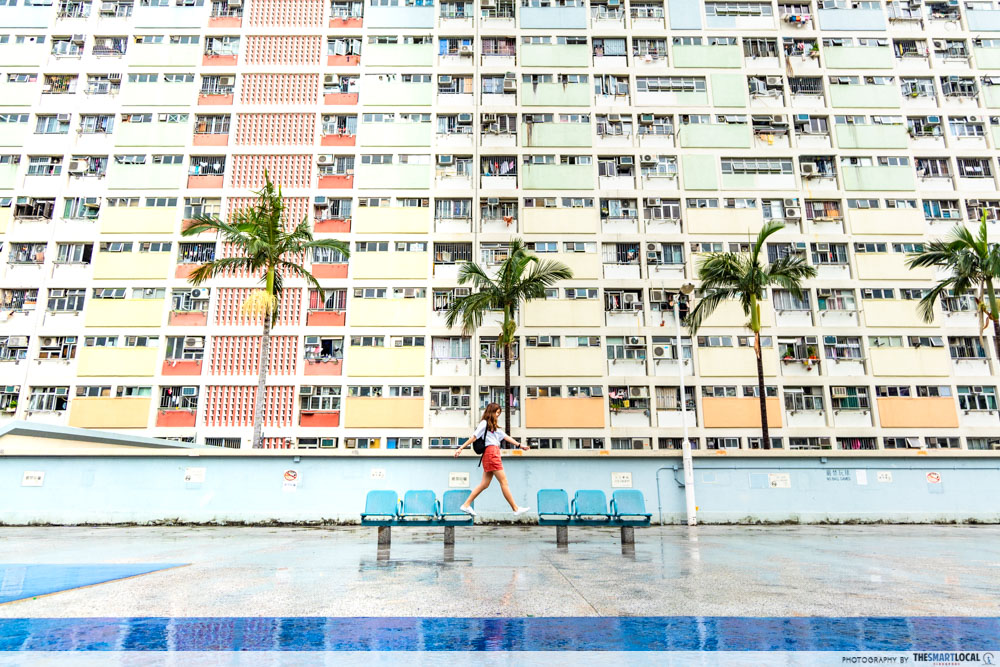 Hong Kong’s version of our Rochor Centre
Hong Kong’s version of our Rochor Centre
Choi Hung, which translates to rainbow in Cantonese, is a vibrant neighbourhood with a stark contrast from Nam Shan’s age-stained walls. According to the locals, the government decided to paint the estate over with delightful palette of colours in order to lift the spirits of residents. It certainly worked, as I felt like I was walking on air once I stood amidst the colourful buildings.
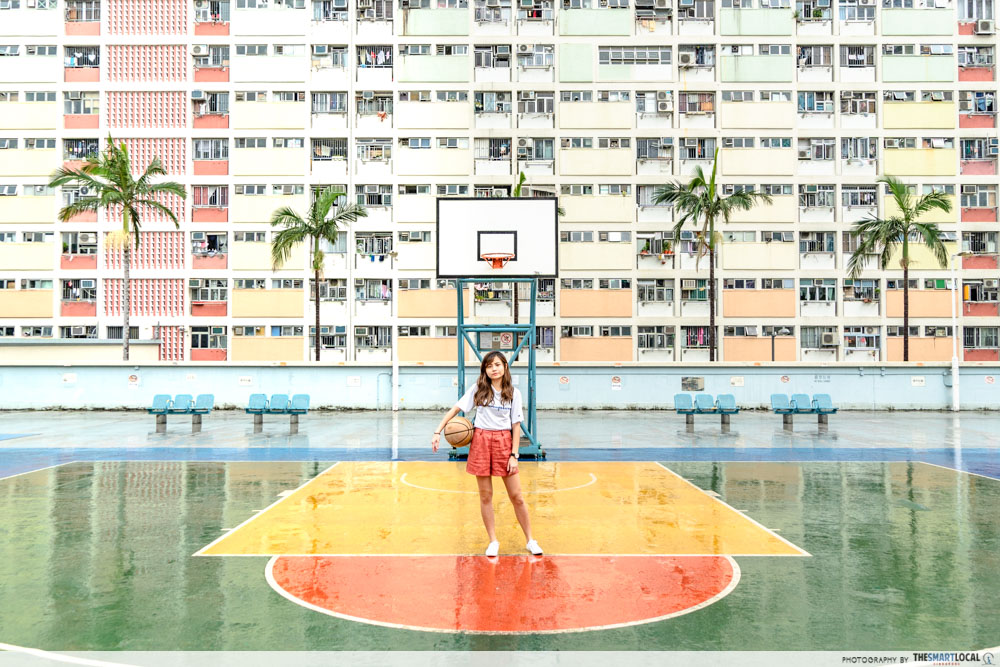
The best spot for photo-taking is the basketball court on the root of the carpark. We saw an interesting mix of people on the court, from residents playing basketball, elderly exercising, and the occasional photographer taking in the architectural marvel.
Nam Shan Estate
Address: Choi Hung Estate, Wong Tai Sin, Kowloon East
Nearest MTR Station: Choi Hung (4 min walk; turn left from Exit A)
Find HK’s last surviving craftsmen who make mahjong tiles and umbrellas
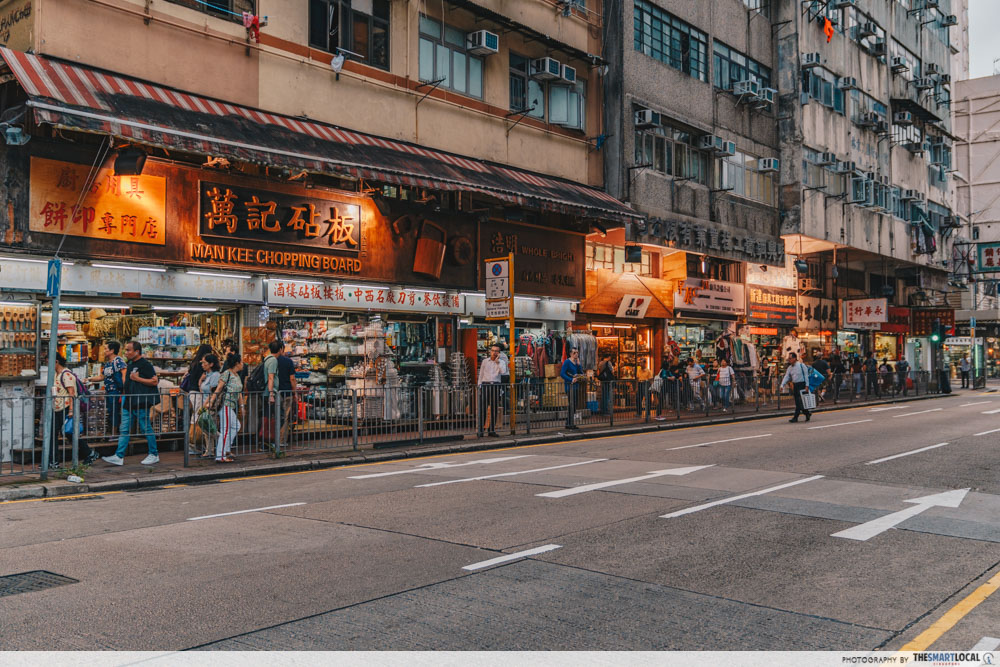 Traditional shops lining the timeless Shanghai Street in Yau Ma Tei.
Traditional shops lining the timeless Shanghai Street in Yau Ma Tei.
Walking through the popular streets of Sham Shui Po and Yau Ma Tei, you’ll uncover gems of shops displaying old-fashioned crafts unique to Hong Kong. These traditional shops are essentially one of a kind, open-air museums offering a close look into the city’s dying trades, and here are a few of the best you should visit before they’re gone forever.
Visiting these traditional shops that each carry with them a piece of Hong Kong’s culture introduced me to a side of the city which I regretted not exploring before. Give these unassuming, old lanes a chance during your next visit, and be set for a memorable ride through time.
4. Cheung Shun King Mahjong – Watch mahjong tiles be carved by hand
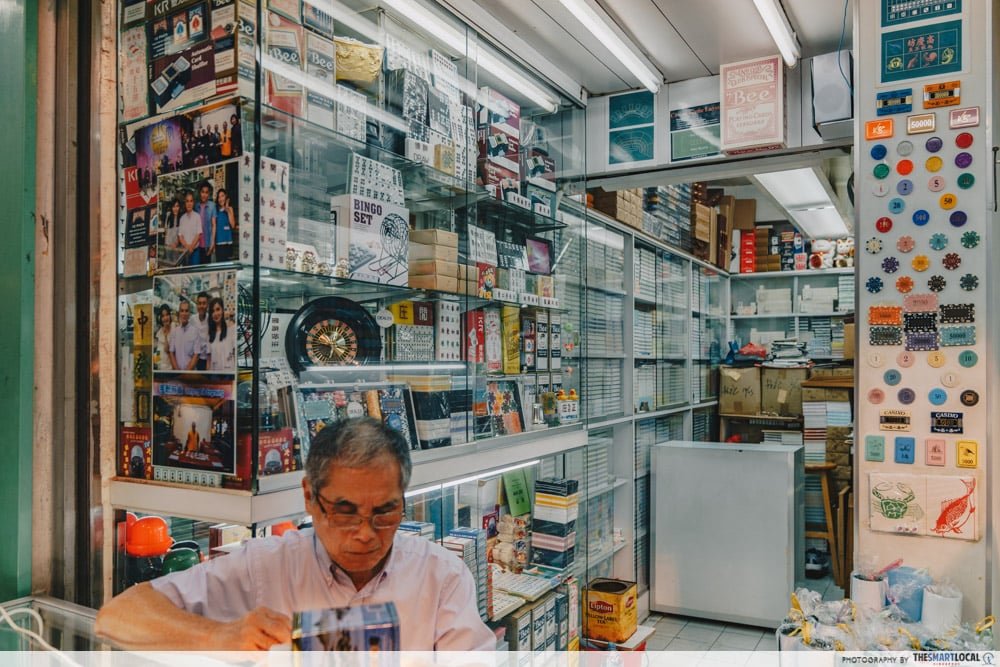 Witnessing one of the few remaining masters of mahjong tile carving hard at work
Witnessing one of the few remaining masters of mahjong tile carving hard at work
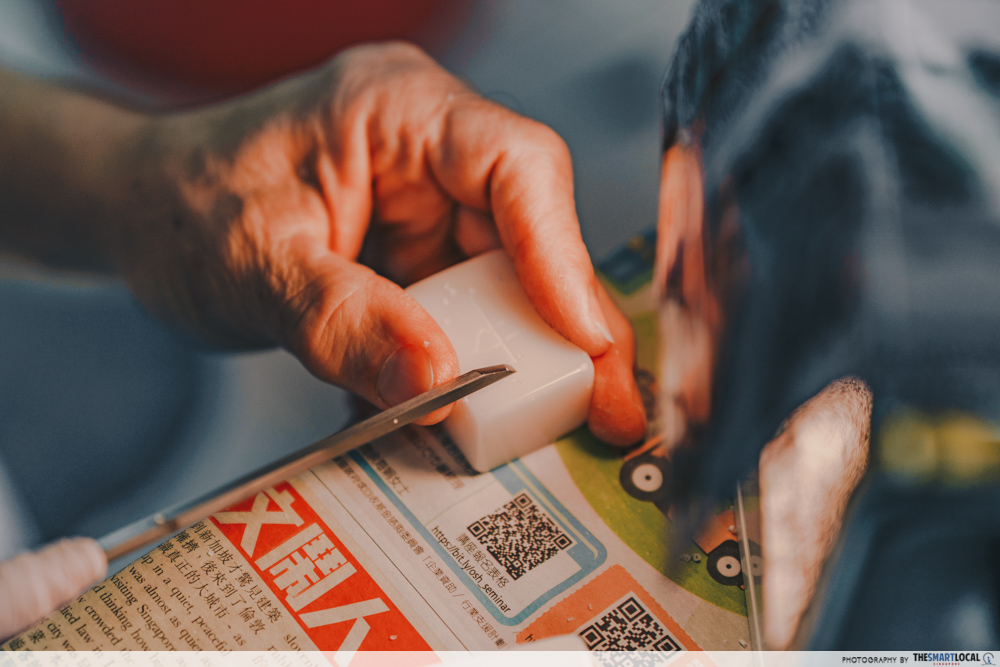 Each tile is carved intricately by hand
Each tile is carved intricately by hand
Singaporeans are no strangers to mahjong, a game many of us consider a highly-competitive sport within our households every February. But behind every “pong!” and “gang!” lies an age-old craft still residing in the streets of Hong Kong.
Cheung Shun King is one of Hong Kong’s remaining artisan mahjong tile carvers. It is no doubt that he is a master of his craft – he carves each tile with high concentration and was sad that we visited his shop before he painted the tiles as “your picture won’t show the beautiful painted tiles!”
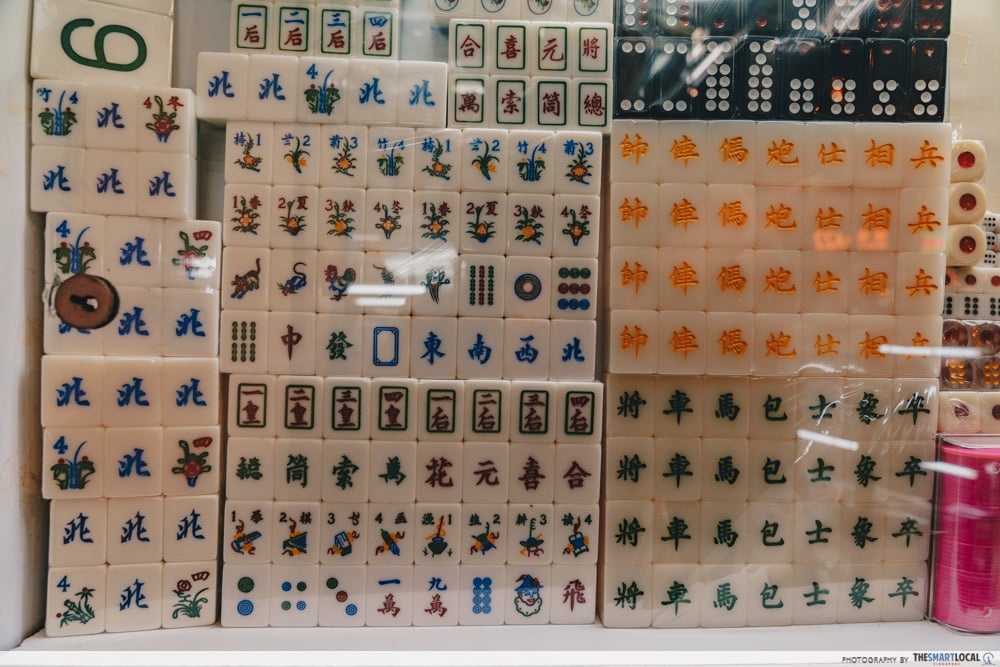 Hand-carved mahjong sets!
Hand-carved mahjong sets!
Each mahjong set takes him around 2 weeks to complete, and it was a special experience to witness a part of the process first-hand.
Cheung Shun King Mahjong
Address: 26 Jordan Road, Yau Ma Tei
Nearest MTR Station: Jordan (3 min walk)
5. Sun Nga Shing Umbrella Store – Get rare handmade umbrellas for bragging rights
This quaint store with umbrellas of every colour and size has been around since 1842, and is fronted by its cheery owner Mr Henry Yau. The store is one of Hong Kong’s remaining umbrella repair shops, and also houses several handmade umbrellas.
While Mr Yau used to handmake the umbrellas sold in his store, he no longer makes them because of the lack of time. Regardless, his love for the craft was clear as he explained his range of umbrellas in avid detail to curious customers.
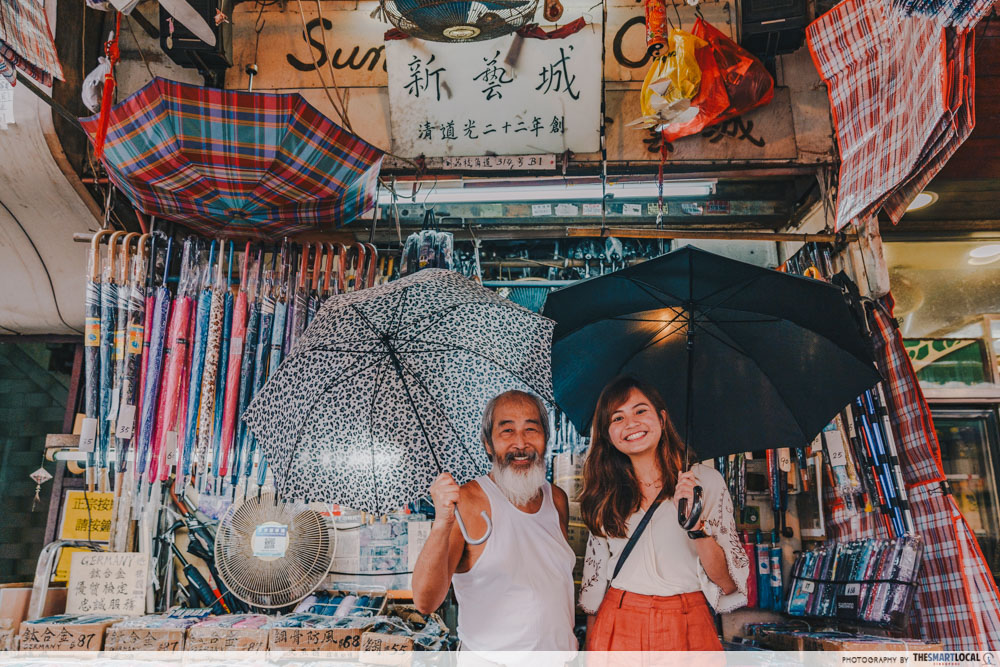 It was a joy talking to the friendly Mr Yau about these umbrellas – a household object we usually don’t think twice about but is the whole world for him
It was a joy talking to the friendly Mr Yau about these umbrellas – a household object we usually don’t think twice about but is the whole world for him
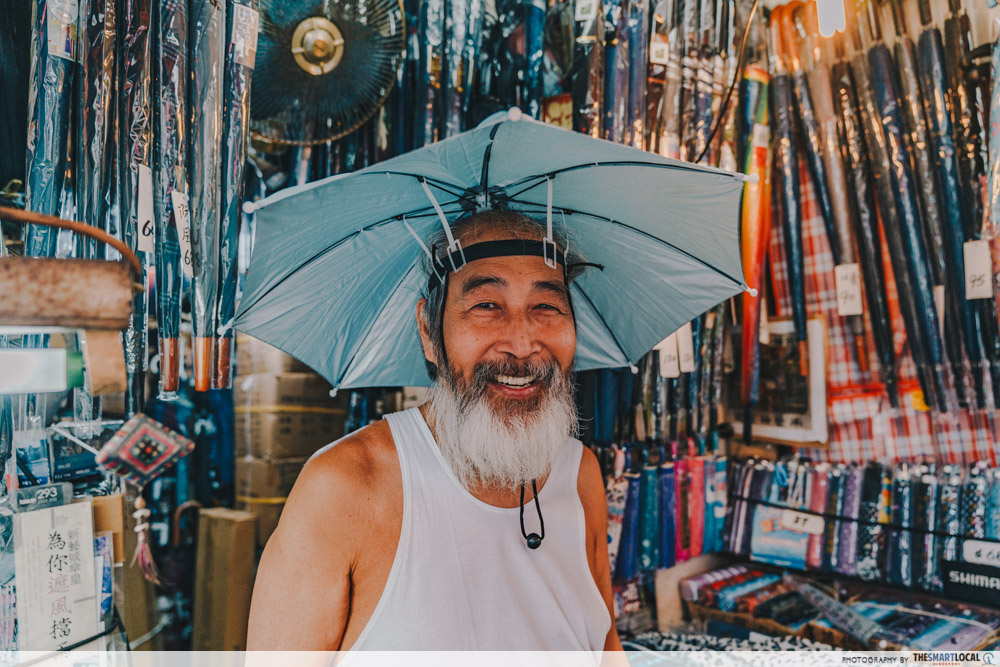 Mr Yau excitedly showing us an umbrella meant for the head because… innovation!
Mr Yau excitedly showing us an umbrella meant for the head because… innovation!
Sun Nga Shing Umbrella Store
Address: Shop B1, 314 Lai Chi Kok Road, Sham Shui Po
Nearest MTR Station: Sham Shui Po (3 min walk)
Opening Hours: 9.30 am – 7.30 pm
6. Wah Ngai Canvas – The birthplace of this iconic red-white-blue bag
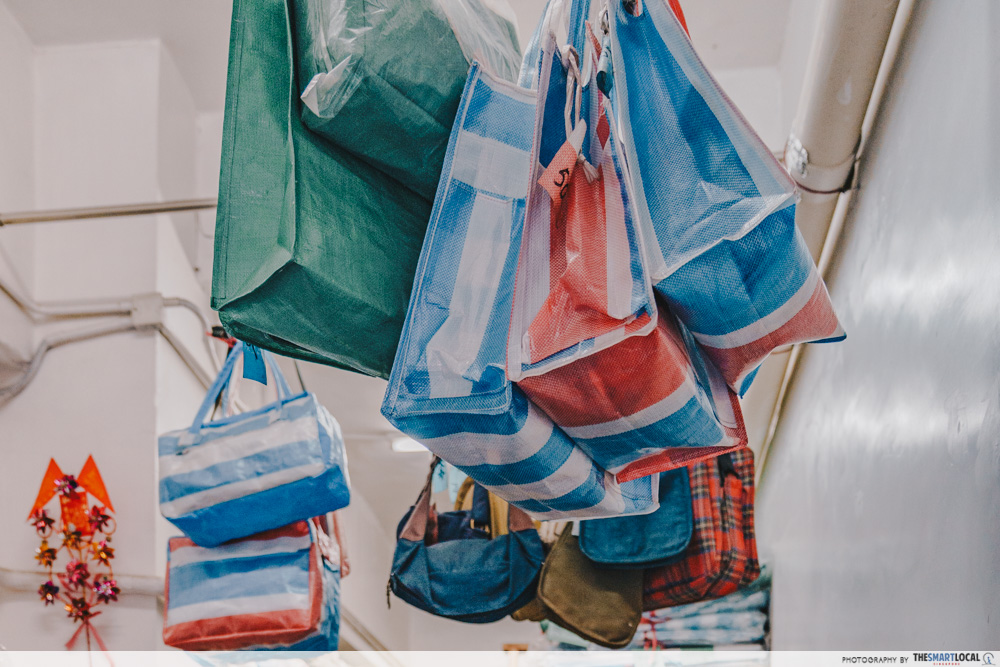 These bags were initially only blue and white, but red was added subsequently to symbolize luck and prosperity
These bags were initially only blue and white, but red was added subsequently to symbolize luck and prosperity
Wah Ngai Canvas is recognised by many as the birthplace of the red-white-blue bags that have since become icons of Hong Kong culture. The bags were first introduced in the 1970s by the shop’s founder Lee Wah, and have been popular with the locals ever since. While he has since passed on, his legendary creations still grace the streets of Hong Kong.
My first step into Wah Ngai Canvas made me appreciate the simpleness of the historic craft compared to its footprint on history – the middle-aged owner sat unassumingly at the corner of the cluttered shop in front of his rusty sewing machine, with canvas bags of various sizes hanging around the shop.
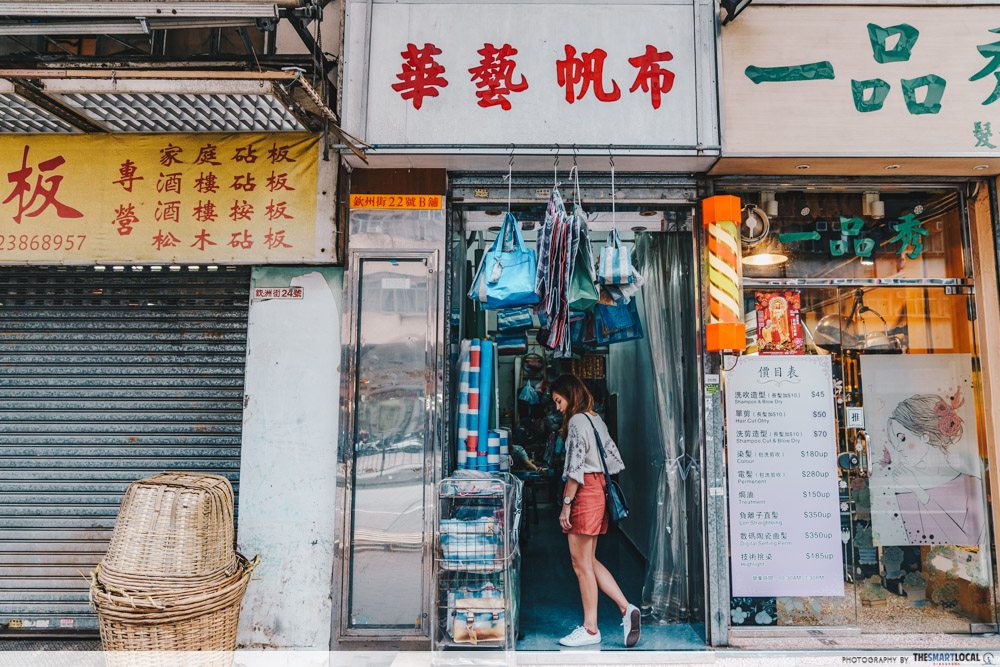 A narrow shop with a wide history
A narrow shop with a wide history
Traditional craftsmanship aside, it was intriguing to see traces of the modern age weaved into the age-old craft – the same canvas is now used to create pencil cases, sling bags and fashion pouches. The next time you visit Hong Kong, consider buying these back as a souvenir!
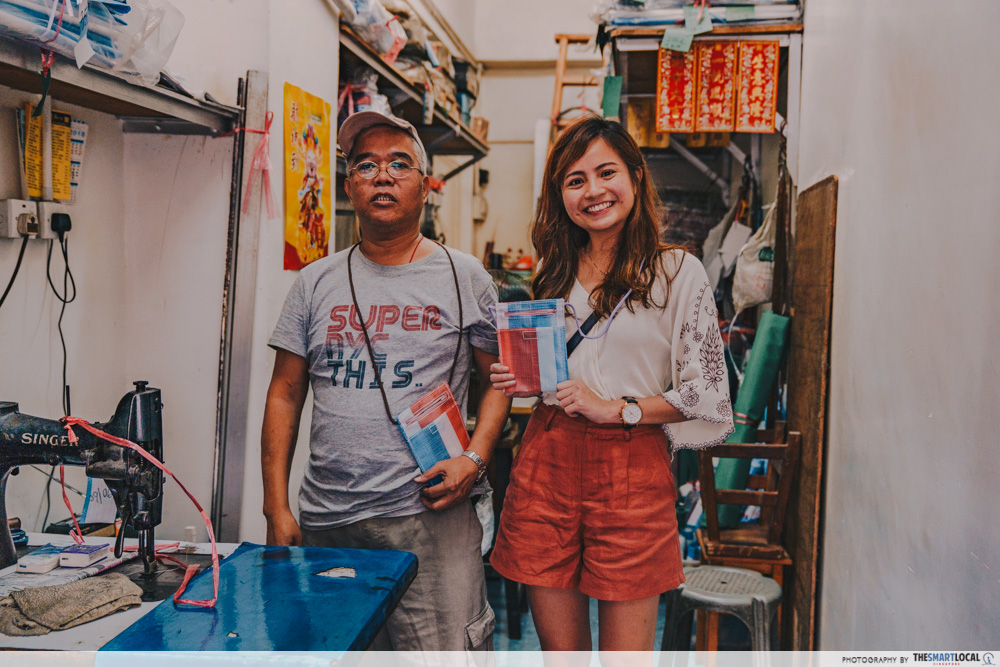 The iconic canvas material repurposed into a “high-fashion” sling bag. The question is, who wore it better?
The iconic canvas material repurposed into a “high-fashion” sling bag. The question is, who wore it better?
Wah Ngai Canvas
Address: 22 Yen Chow Street, Sham Shui Po
Nearest MTR Station: Sham Shui Po (6 min walk)
Opening Hours: 8 am – 5.30 pm
7. Lee Wo Steelyard – The last shop in Hong Kong with handmade weighing scales
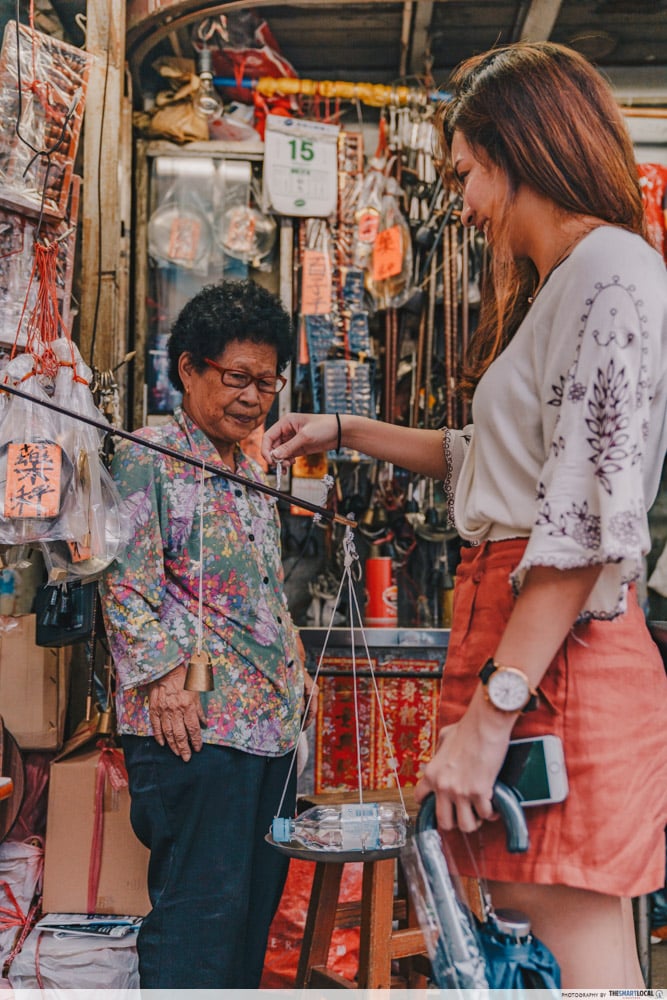 An object is placed on a metal tray on one end of the scale, which is counterbalanced by a weight hanging on the other end
An object is placed on a metal tray on one end of the scale, which is counterbalanced by a weight hanging on the other end
Steelyards are traditional handmade scales used to measure weights before fancy digital balances were introduced. This humble shop nestled in the streets of Yau Ma Tei was established in the 1930s and is the last of its kind in Hong Kong. It is definitely worth a visit before the vanishing craft dissolves forever.
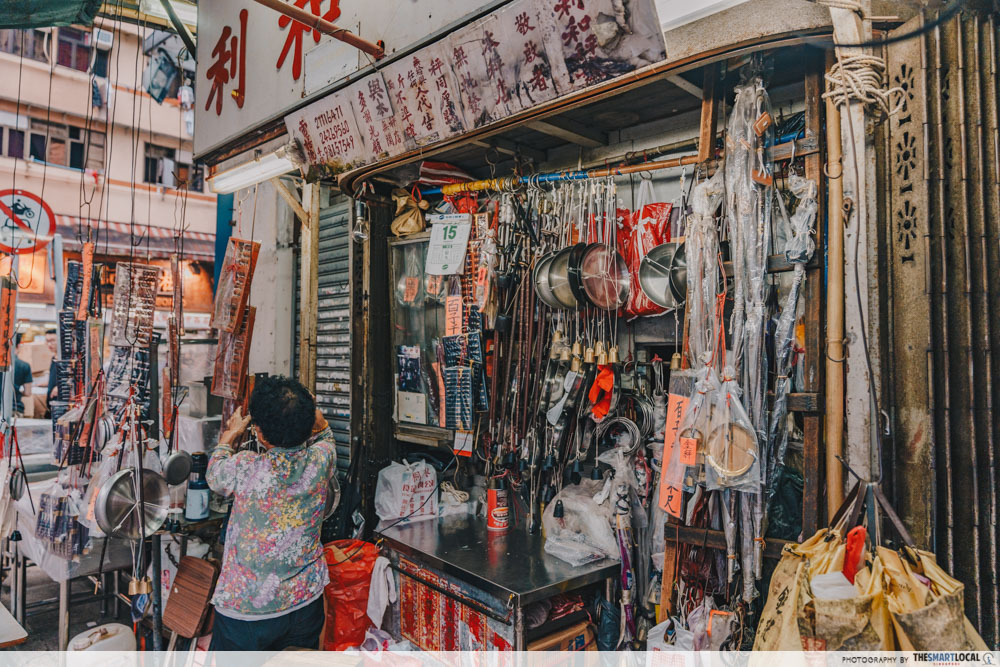 Mrs Ho carefully arranging the array of handmade tools at her shop
Mrs Ho carefully arranging the array of handmade tools at her shop
The Chinese scale works by balancing an object and a sliding weight on both ends of a wooden stick, then reading off the numbers hand-painted on the stick. The scales are all made from scratch by Mrs Ho, who paints and pieces together the apparatus by hand.
Lee Wo Steelyard
Address: Intersection between 345 Shanghai Street and Shek Lung Street
Nearest MTR Station: Yau Ma Tei (5 min walk)
Grab a bite at the traditional Dai Pai Dongs in Sham Shui Po
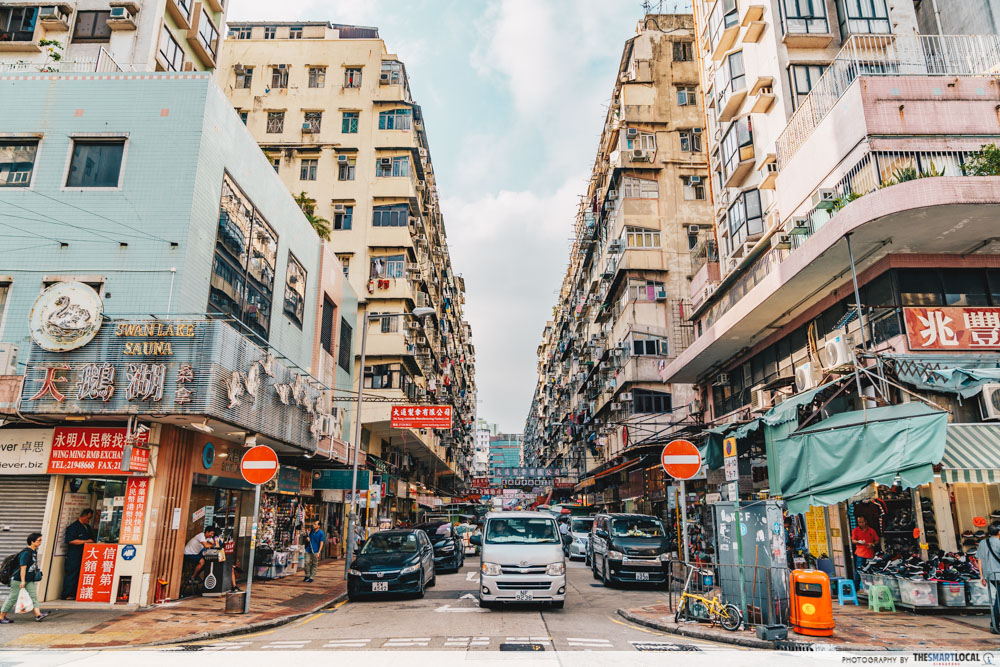
Imagine our local hawker stalls stripped of their roofs and scattered along main roads. Dai Pai Dongs (大牌档), an iconic piece of Hong Kong’s food culture, is something like that. They are old-fashioned outdoor eateries which have stood the test of time. Expect nothing less than comforting, authentic dishes at these fuss-free eateries, an important part of the classic Hong Kong experience.
Bearing in mind that all cooking, preparing, and washing are done outdoors, the eating environment at Dai Pai Dongs can get pretty grimy. But once you look past the nondescript exteriors, dining at these eateries will make for a memorable experience. We started our food trail in Sham Shui Po for a taste of traditional Hong Kong, and left with two very satisfied bellies.
9. Oi Man Sang – Stir fried beef and sweet and sour pork
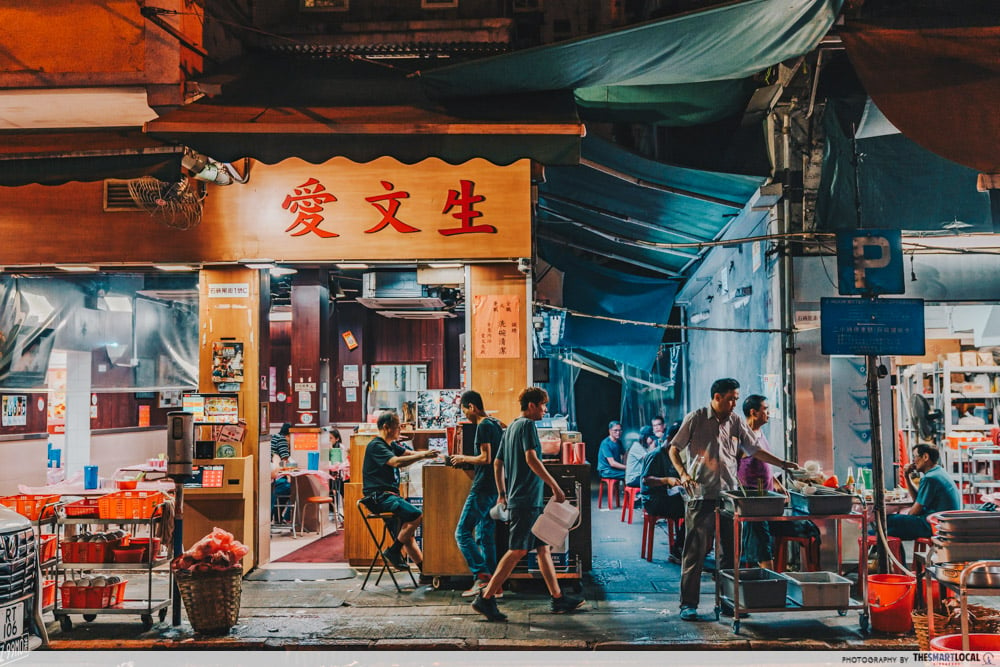 The famous dai pai dong was teeming with customers when we arrived
The famous dai pai dong was teeming with customers when we arrived
Oi Man Sang is considered pretty grand in the world of Dai Pai Dongs. Since its opening way back in 1956, it has expanded into a bustling eatery offering both indoor and outdoor seating. This stall was one of the top recommendations for Dai Pai Dongs in Hong Kong, and the crowds we saw when we visited was a testament to that.
Their menu is similar to what you might find at a zi char stall in Singapore, with signature dishes like stir-fried black pepper beef and sweet and sour pork.
We ordered the black pepper beef which had unfortunately ran out, so the friendly staff offered to cook up another stir-fried beef dish for us instead.
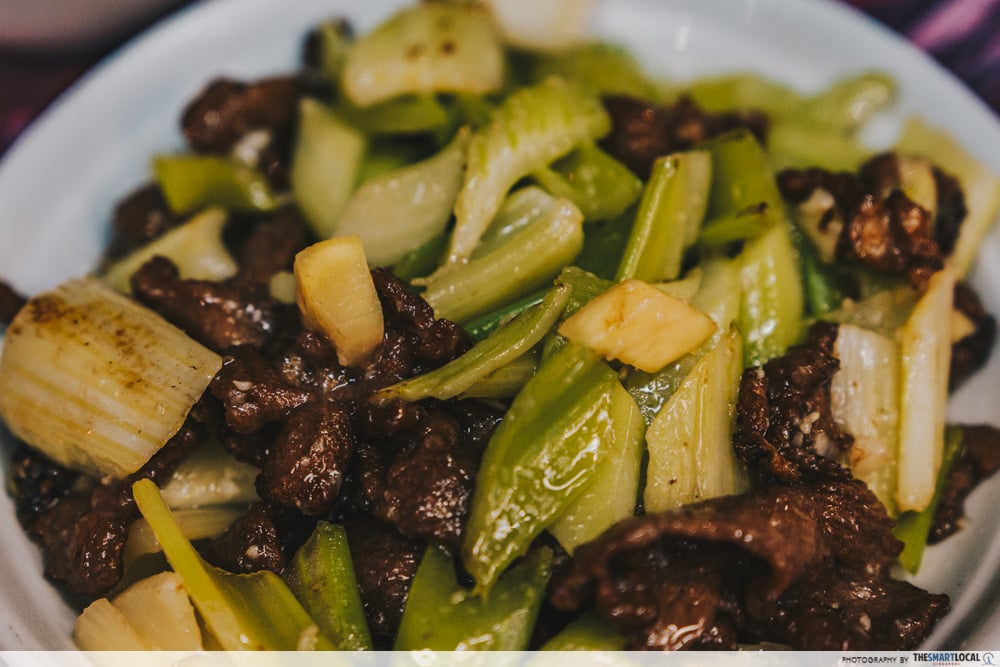
The beef slices were very well-seasoned and tender, and every piece melted deliciously in my mouth. I was certain I could down the whole plate, but I resisted the urge and saved some room for my next dish.
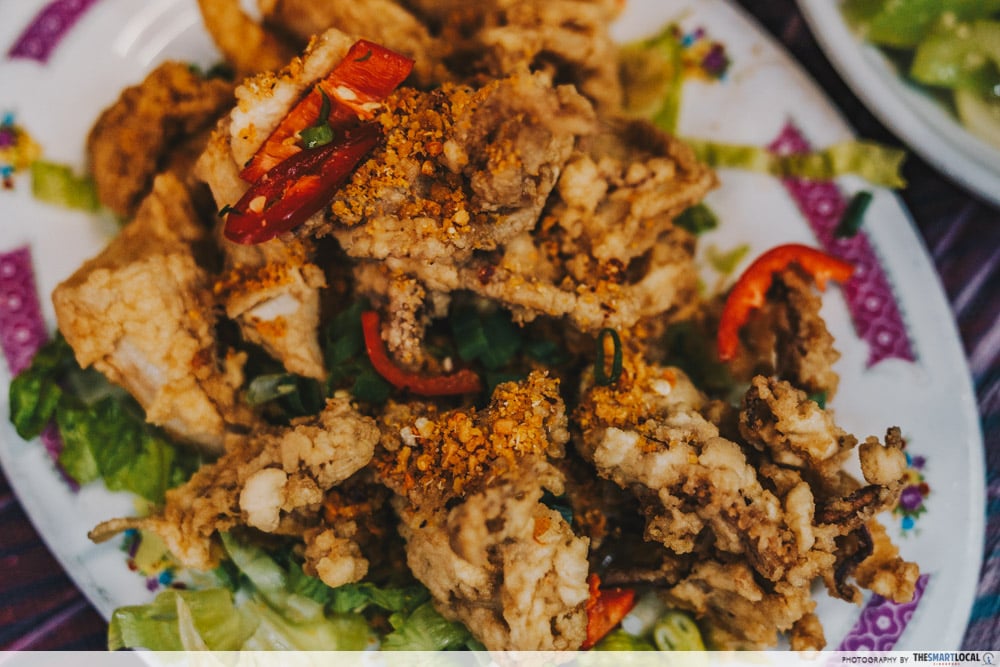
We also had the fried squid with peppered salt, which gave a satisfying crisp with every bite and paired well with the accompanying vinegar dip.
Oi Man Sang
Address: 215 Lai Chi Kok Road, Sham Shui Po
Nearest MTR Station: Sham Shui Po (7 min walk)
Opening Hours: 5.30 pm – 12.45 am
10. Cheung Fat Noodles – Fishball noodles and wanton noodles
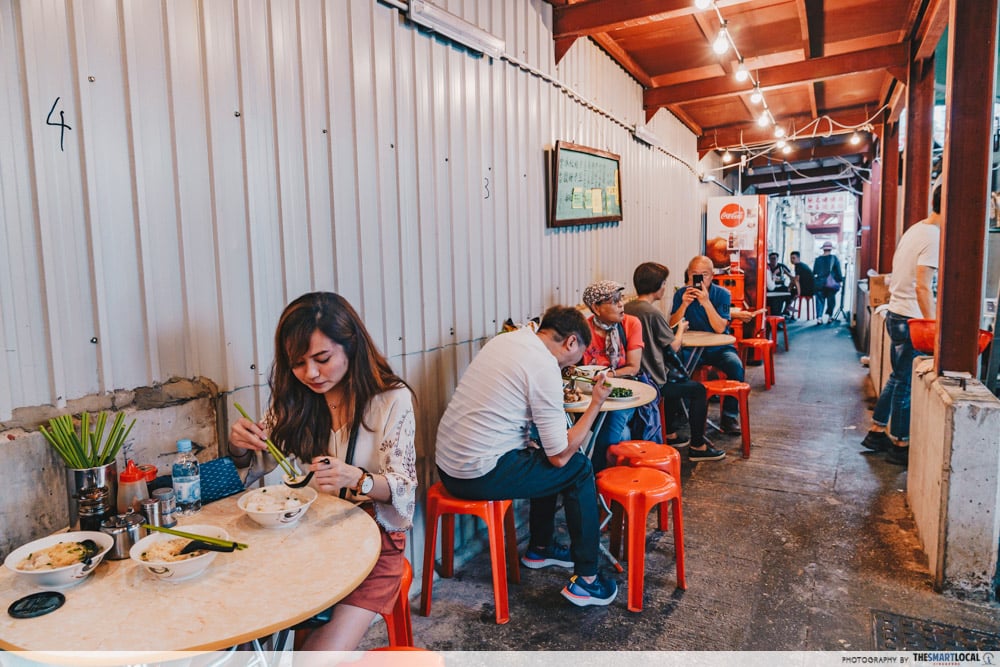 It’s more than meets the eye at this stall hidden away in one of the endless alleyways on Sham Shui Po
It’s more than meets the eye at this stall hidden away in one of the endless alleyways on Sham Shui Po
As one of the oldest noodle shops in Hong Kong, this is a must-visit for all my fellow noodle lovers. A few tables and chairs fill a narrow alleyway right beside the open-air kitchen, creating a cosy space tucked away from the main streets.
The sole, hanging menu lists the variations of noodles available, from pork knuckle noodles to the all-time-classic fishball noodles.
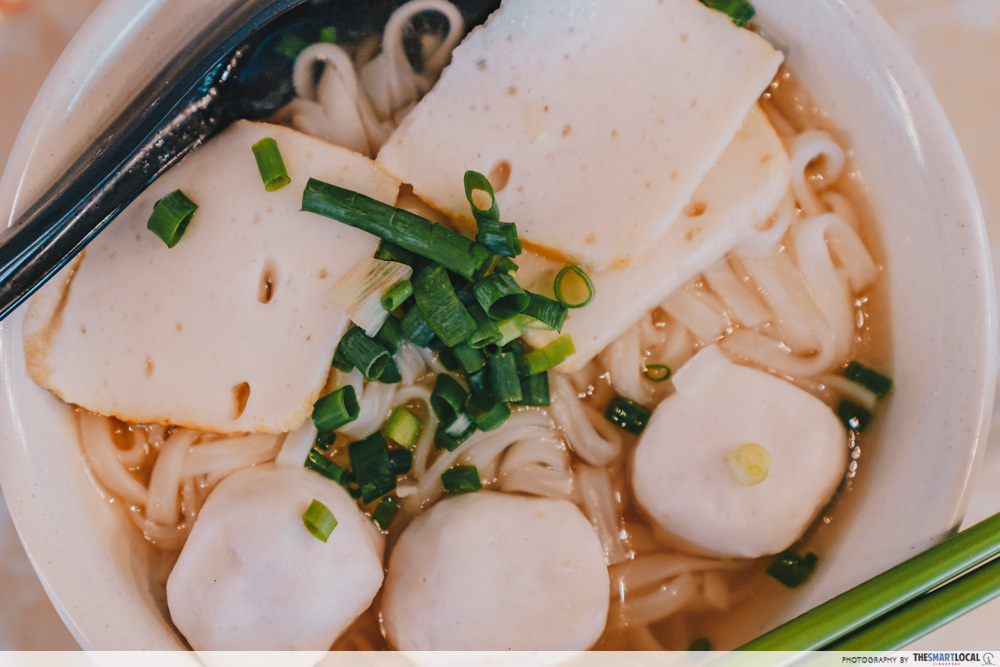
We ordered the fishball noodles and wanton noodles, which came with a generous amount of ingredients floating on a bed of hearty soup. At just 28 HKD (~S$5) a bowl, the meal was absolutely value-for-money and fully satisfied the aunties in us.
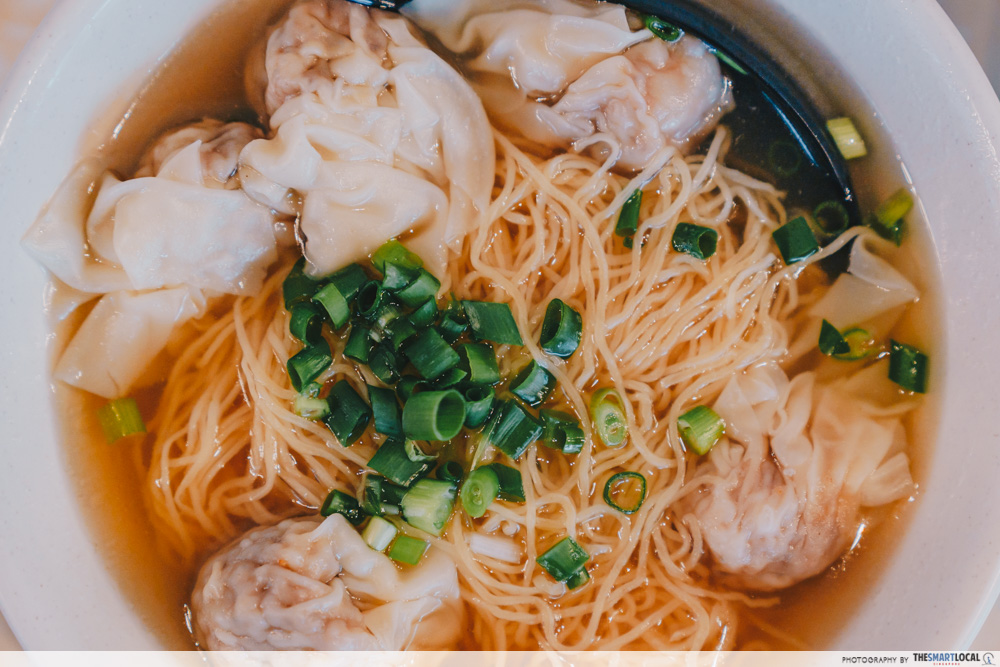
The wanton mee checked all the boxes of my colleague Gabriel, who awarded it the high honour of, I quote, “Crystal Jade standard”. I on the other hand, was completely sold by the homemade fishballs of the fishball noodles, which were plump and flavourful.
If this store were to be a hawker stall in Singapore, I have no doubt it would attract a crazy queue every lunch hour.
Cheung Fat Noodles
Address: 14 Yiu Tung Street, Sham Shui Po
Nearest MTR Station: Sham Shui Po (5 min walk)
Opening Hours: 11 am – 2.30 am
Bonus: Take a 15 min trip on the High Speed Rail to the MUJI Hotel in Shenzhen
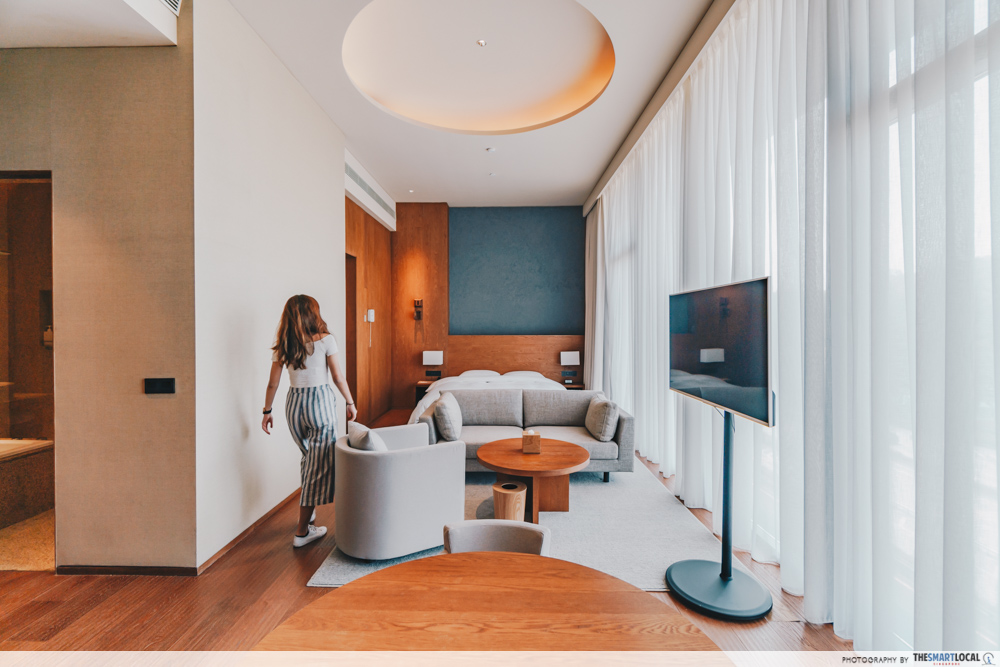 With a room like this, you’ll never want to leave the hotel
With a room like this, you’ll never want to leave the hotel
I am a sucker for all things MUJI, so visiting the MUJI Hotel basically meant I could fulfil my long-standing (and probably illegal) dream of staying overnight in a MUJI store. And visiting Hong Kong after the new High Speed Rail connecting Hong Kong, Shenzhen, and Guangzhou was built, this dream was within my grasp.
Details on how to get to the MUJI Hotel below.
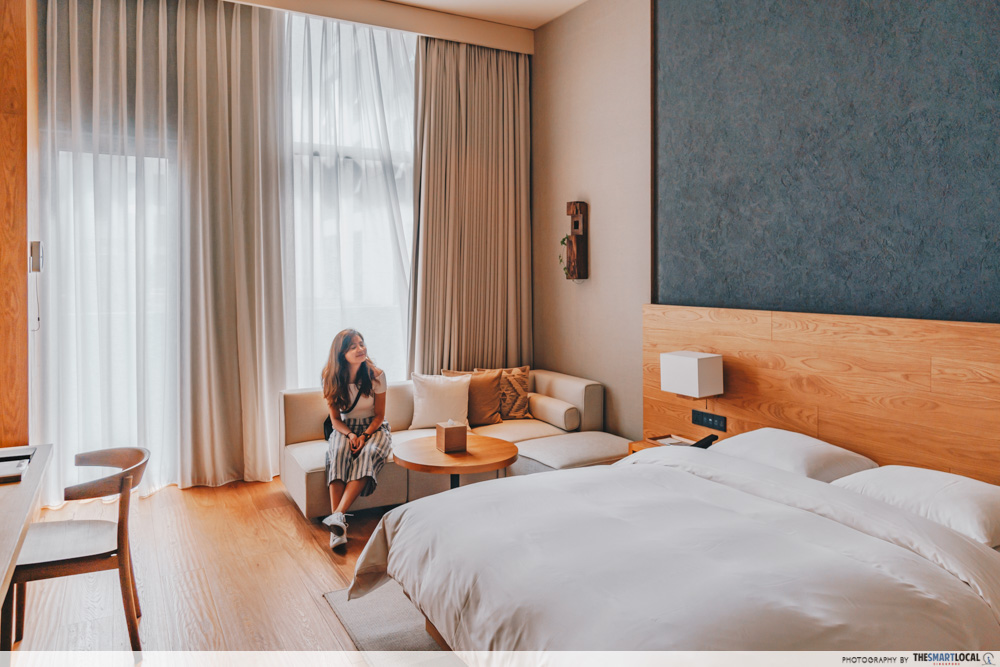
I went into the hotel expecting to walk right into a MUJI catalogue, and it did not disappoint. Each room contains more than 70% of MUJI products, including luxurious bedroom slippers, toiletries, and the ultra-comfortable bed which made me feel like I was lying on a sea of fluffy clouds.
And it doesn’t end there – the hotel even has a MUJI library, gym, and a fancy diner.
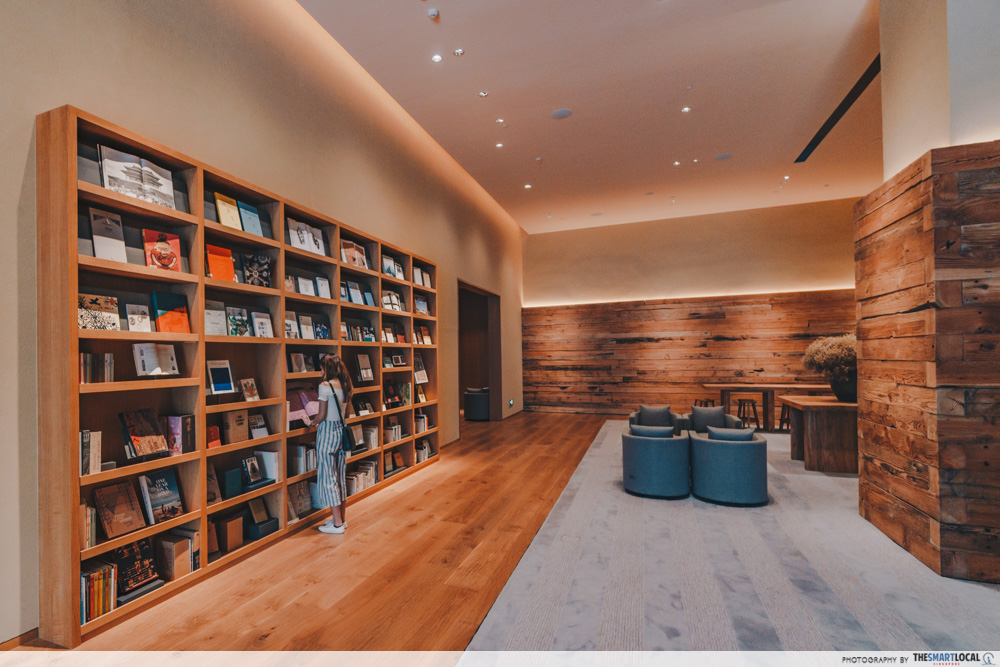 The library takes up an entire floor in the hotel and has a full shelf of books of different genres
The library takes up an entire floor in the hotel and has a full shelf of books of different genres
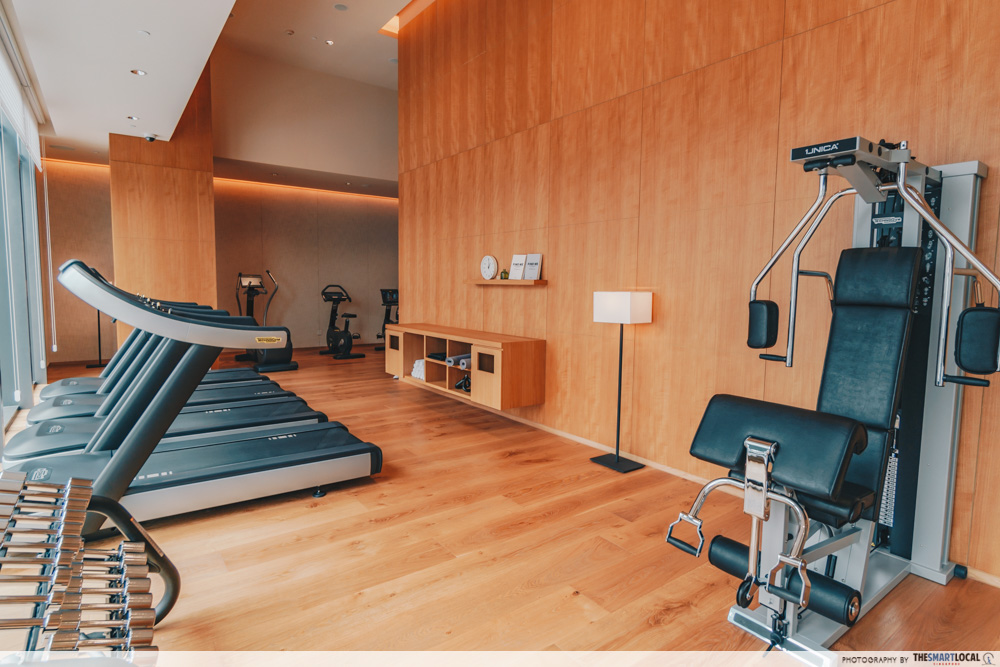
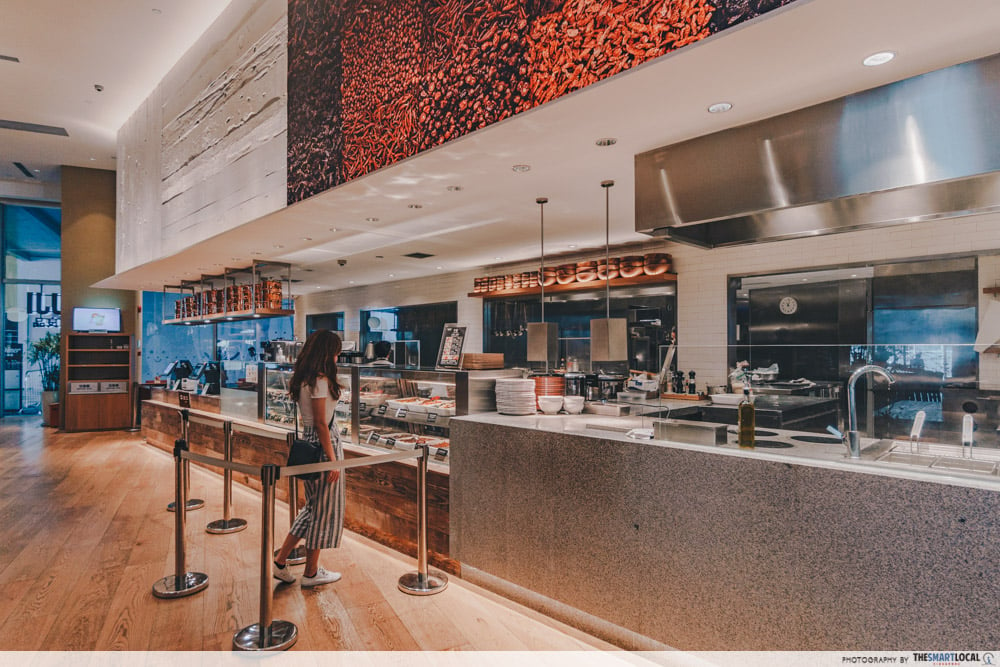 A stay at the hotel also comes with free breakfast!
A stay at the hotel also comes with free breakfast!
With these distinctively MUJI facilities, the hotel was basically a MUJI wonderland. You can bet that I spent as many waking hours possible that day enjoying the stay of my dreams. Absolutely worth a day trip out of Hong Kong for!
Getting to the MUJI Hotel
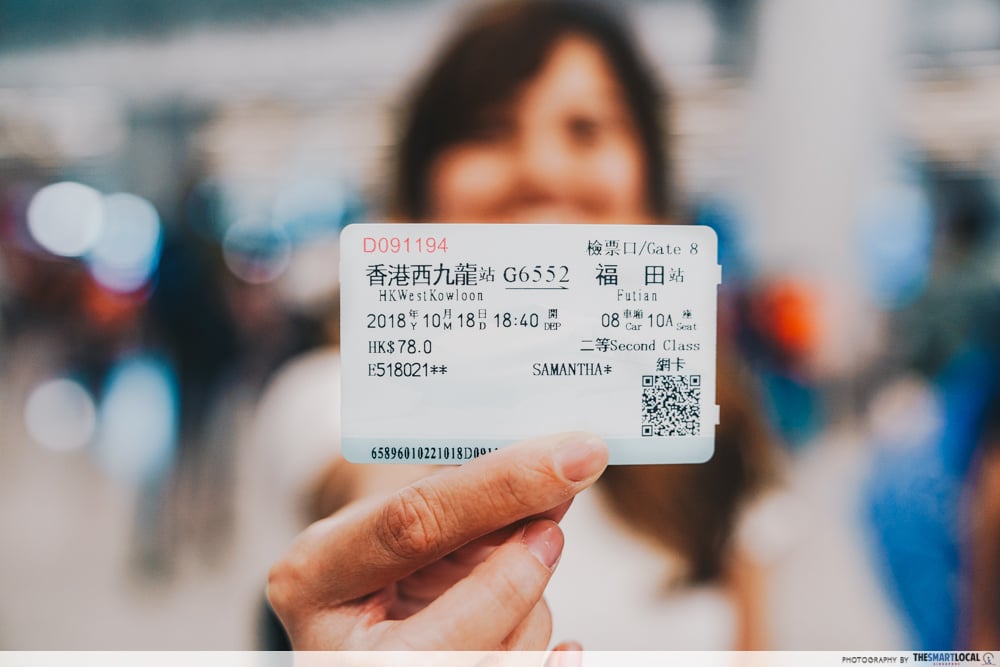 A round trip ticket from Hong Kong to Futian costs only 156 HKD (~SGD 27.50) per person
A round trip ticket from Hong Kong to Futian costs only 156 HKD (~SGD 27.50) per person
The train journey took us a mere 15 minutes from Hong Kong West Kowloon Station to Futian Station in Shenzhen. Imagine this – I can travel to another country quicker than it takes for me to travel to work.
 The train seats were spacious and cosy – it pretty much felt like an economy plus plane seat, minus the turbulence
The train seats were spacious and cosy – it pretty much felt like an economy plus plane seat, minus the turbulence
After alighting at Futian Station, take the metro on Line 2 to Gangxia North Station before heading to MUJI Hotel.
MUJI Hotel
Address: 5001 Huanggang Rd, Shenzhen, UpperHills City Complex Level 2
Book the High Speed Rail tickets here.
Unique experiences in Hong Kong
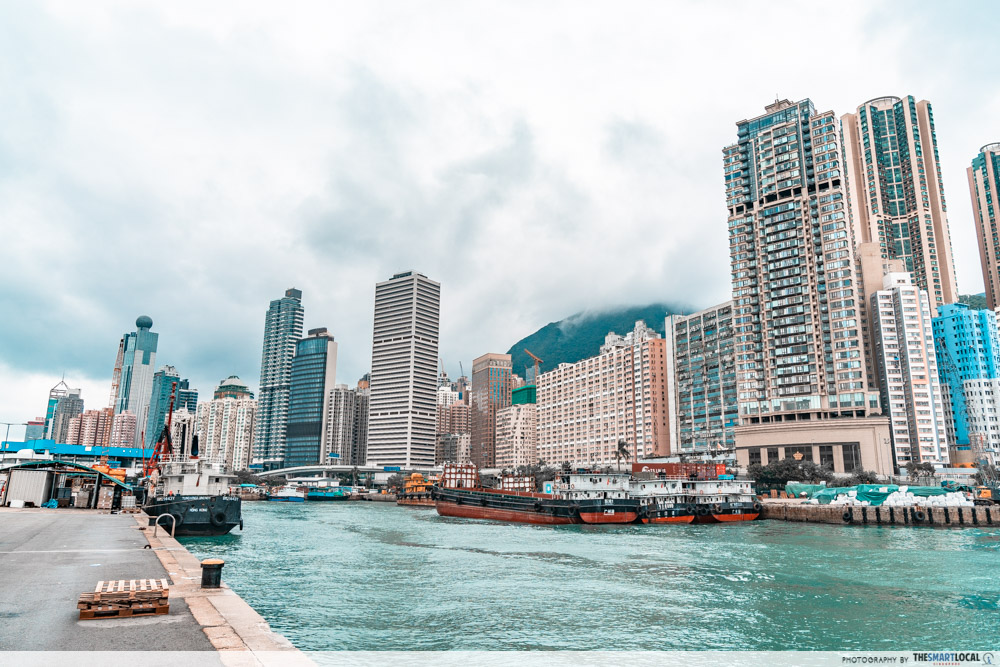
With boundless new things to do in Hong Kong, you’re definitely in for a ride the next time you visit. Be it traversing the surviving fragments of old school Hong Kong or exploring modern, millennial-friendly places, these experiences will take you on a spectacular journey of rediscovering the dynamic city.
Get promotional airfares, free tours and discount coupons for Hong Kong here!
This post was brought to you by Hong Kong Tourism Board.
Photography by Gabriel Seow.




